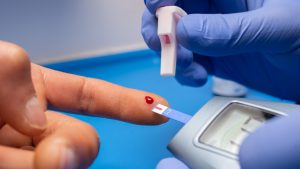As we approach 2025, innovations and shifts in healthcare are transforming how people manage diabetes. Staying informed about these trends can help you harness the latest tools and strategies for better well-being. Here are the most impactful developments to look forward to in the coming year.
1. Advanced Glucose Monitoring Systems
Technology continues to evolve, making diabetes management more efficient and accurate:
Non-Invasive Glucose Monitoring: Devices that measure glucose levels without needles are gaining traction, offering a pain-free experience.
Integration with Smart Devices: Many continuous glucose monitoring (CGM) systems now sync seamlessly with smartphones, smartwatches, and other wearables, providing real-time insights and notifications.
AI-Enhanced Monitoring: Artificial intelligence is being used to predict glucose trends and suggest preemptive actions to maintain stable levels.
2. Personalized Medicine
The era of one-size-fits-all healthcare is fading as treatments become more tailored:
Genetic Profiling: Advances in genomics allow for customized diabetes care plans based on individual genetic markers, optimizing medication and lifestyle recommendations.
Microbiome-Based Therapies: Research into gut health is uncovering new ways to enhance insulin sensitivity and overall glucose control through microbiome modulation.
Precision Insulin: Innovations in insulin formulations are delivering faster-acting and longer-lasting effects, closely mimicking natural pancreatic responses.
3. Digital Health and Telemedicine
Remote healthcare continues to expand, making expert support more accessible:
Virtual Consultations: More healthcare providers are offering telemedicine options, allowing for regular check-ups and consultations from home.
Remote Monitoring: Devices now enable healthcare professionals to monitor glucose levels and adjust treatment plans in real time.
Digital Coaching Programs: Personalized coaching apps provide tips, reminders, and encouragement to maintain healthy habits.
4. Focus on Holistic Wellness
The connection between physical, mental, and emotional health is gaining recognition:
Mind-Body Interventions: Practices like yoga, meditation, and biofeedback are being integrated into diabetes care plans to reduce stress and improve glucose control.
Emotional Support Tools: Apps and communities dedicated to mental health for people with diabetes are growing, offering a safe space to share experiences and challenges.
Nutrition Beyond Calories: Emphasis on anti-inflammatory diets, gut health, and food quality is shaping new dietary guidelines for diabetes management.
5. Smart Insulin Delivery Systems
Technology is reshaping insulin therapy with enhanced convenience and accuracy:
Automated Insulin Delivery (AID): Closed-loop systems combining CGM and insulin pumps are getting smarter, requiring less manual intervention.
Patch Pumps: Wearable devices are becoming more discreet and user-friendly, simplifying insulin delivery.
Real-Time Dose Adjustments: AI-powered algorithms help fine-tune insulin doses based on activity, stress, and other factors.
6. Accessibility and Inclusivity in Diabetes Care
Efforts are being made to make diabetes management tools and education available to everyone:
Affordable Medications and Devices: Governments and organizations are working to lower costs and expand access to essential diabetes supplies.
Culturally Relevant Resources: Educational materials and dietary advice tailored to diverse populations are becoming more widespread.
Community Health Programs: Local initiatives are helping underserved communities receive the support they need.
7. Innovations in Diabetes Research
The future of diabetes care is being shaped by groundbreaking studies and trials:
Regenerative Medicine: Stem cell therapies and beta-cell replacement strategies are showing promise for restoring insulin production.
Preventive Vaccines: Trials for vaccines aimed at preventing type 1 diabetes in at-risk individuals are underway.
New Medications: Novel drug classes targeting glucose metabolism, weight management, and cardiovascular health are entering the market.
8. Empowering Self-Management
Education and empowerment are key to effective diabetes care:
Interactive Learning Platforms: Gamified apps and virtual reality (VR) tools make diabetes education engaging and accessible.
Wearables with Behavioral Insights: Devices not only track metrics but also provide actionable advice based on user habits.
Data-Driven Decisions: Platforms that integrate data from multiple devices give users a comprehensive view of their health trends.
How to Stay Ahead
To make the most of these trends:
Stay Informed: Follow reputable sources and updates from diabetes organizations.
Engage with Your Care Team: Discuss new technologies or treatments with your healthcare provider.
Join Communities: Connect with others to share experiences and learn about emerging tools.
2025 is poised to be a year of significant progress in diabetes care. By embracing these trends, you can take proactive steps toward a healthier, more empowered future. 🌟

Type 2 Diabetes: Is It Really Reversible?
A recent National Geographic article [link] explores how type 2 diabetes could be reversible with the right approaches. This condition, which affects millions of people worldwide, has long been considered a chronic and progressive disease. However, recent research challenges this perception and suggests that with lifestyle changes and the right approach, remission is possible. The

How Do GLP-1 Drugs Compare? A Breakdown of Ozempic, Mounjaro, and Trulicity
GLP-1 receptor agonists have revolutionized diabetes management, with drugs like Ozempic, Mounjaro, and Trulicity leading the market. But how do these medications compare in terms of effectiveness, side effects, and patient outcomes? Let’s explore their differences and what they mean for diabetes patients. Understanding GLP-1 Medications GLP-1 receptor agonists mimic a natural hormone that helps

Why Has Medicare Spending on Diabetes Medications Skyrocketed in 5 Years?
In the past five years, Medicare spending on diabetes medications has increased nearly fivefold, reaching $35.8 billion in 2023. This surge has been primarily driven by the growing use of GLP-1 drugs such as Ozempic, Mounjaro, and Trulicity. But what is behind this cost escalation, and how does it affect patients and the U.S. healthcare

The Gut Microbiota and Blood Sugar Control: A Hidden Connection
The human gut is home to trillions of bacteria that play a crucial role in digestion, immune function, and even metabolism. Recent research has revealed a fascinating link between the gut microbiota and blood sugar regulation, shedding light on how the balance of microbes in our intestines can influence diabetes risk and overall metabolic health.

The Dawn Phenomenon: Why Blood Sugar Rises While You Sleep
For many people with diabetes, waking up with high blood sugar levels can be frustrating—especially if they didn’t eat anything overnight. This early-morning spike in blood glucose is known as the Dawn Phenomenon, and it happens due to natural hormonal changes in the body. But why does it occur, and how can it be managed?

The Influence of Red Light on Blood: Can It Improve Diabetes?
Type 2 diabetes is a metabolic disease characterized by insulin resistance and elevated blood glucose levels. In the search for complementary alternatives to improve glycemic control, red light therapy has gained attention due to its potential to enhance circulation, reduce inflammation, and optimize cellular function. But what does science say about it? ✨ What is

